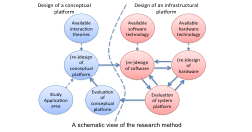Seamless integration of wearable computers & public displays for mobile collaboration in hospital
01 March 2012
Abstract of the Project
Healthcare is one of the most collaborative domains of work in the world and many technologies have been developed for collaborative clinical settings. While nowadays Electronic Patient Record systems, wireless networks and mobile devices are supporting distribution of medical information among clinicians, the challenge of accessing right information, in right place, at the right time still exists. Also the mobility nature of the work in hospitals to achieve a right configuration of people, resources, knowledge, and place to accomplish tasks is increasing need for situation-based and spontaneous interaction technologies. By moving from a desktop interaction metaphor to a mobile paradigm, we are witnessing the emergence of human-body centric approach and it’s associated situative space model which focuses on human perceivable and manipulable spaces for determining appropriate modalities for a given individual in a given context. While the egocentric interaction approach opens new horizons for designing more effective techniques for individual-oriented interaction, the question is how such human-centric approach can be used to design mobile systems in collaborative settings. This project targets the development and evaluation of interaction technology for wearable computers to support mobile collaboration in hospital setting. Specific focus will be paid on mixed-reality session establishment, multimodal interaction, and context-sensitive user interface adaptation based on the situation. A wearable system prototype that provides activity support both at an individual level and in collaborative settings will be designed and evaluated together with hospital partners.

Research Achievements to date
- A draft version of extended situative space model for collaboration
- A wearable health monitoring system on smartphone

References
[1] J.Bardram, C. Bossen. Mobility Work: The Spatial Dimension of Collaboration at a Hospital, ICSCW Journal 14, pp131-160, 2005.
[2] T. Pederson, L-E. Janlert, D. Surie. Setting the Stage for Mobile Mixed- Reality Computing - A Situative Space Model based on Human Perception, IEEE Pervasive Computing, 2011.
[3] Sh. Jalaliniya, T. Pederson. A Wearable Kids’Health Monitoring System on Smartphone, Proceeding of NordiCHI 2012.
Health Monitoring System Smartphone: http://pitlab.itu.dk/teaching/students/previous-project/wearable-kids%E2%80%99-health-monitoring-system-smartphone
Collaborations
- Wearable Computing Lab, ETH University, Switzerland
- Bispebjerg Hospital, Denmark

